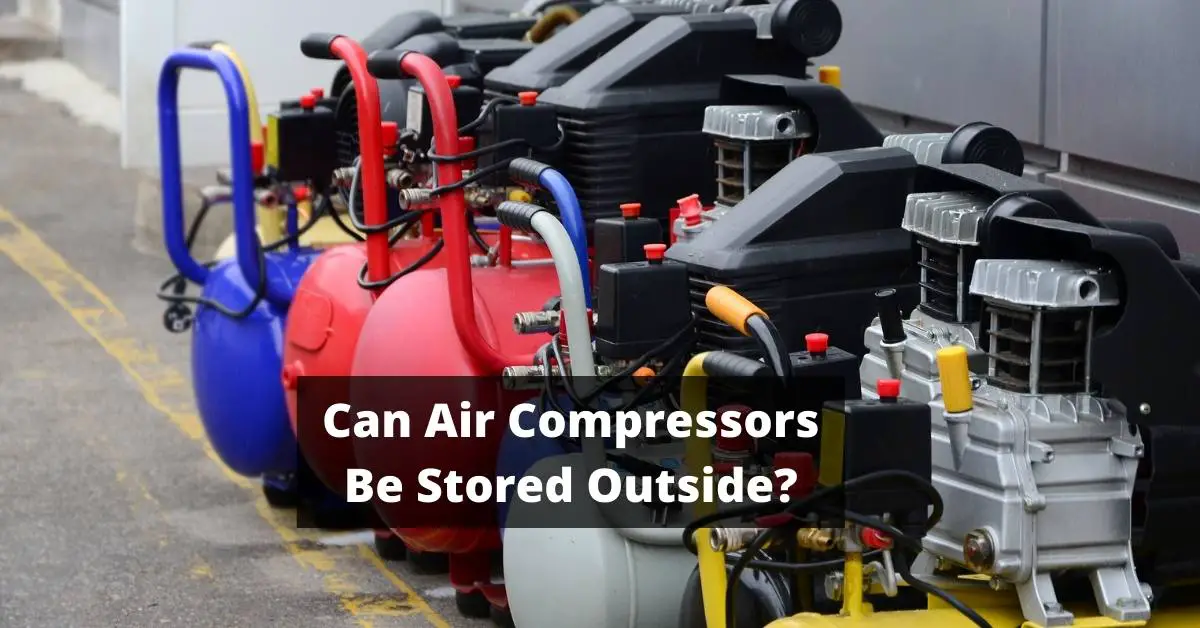Hey there, fellow DIY enthusiasts!
Are you tired of constantly having to stop your air compressor mid-project just to wait for it to refill? Do you find yourself wanting an extended period of continuous use without the need to turn off and on your compressor repeatedly?
Well, the solution is simple: add an auxiliary tank to your air compressor!
As someone who has been in the DIY game for quite some time now, I can tell you that adding an auxiliary tank to your air compressor is a game-changer. It not only increases the amount of compressed air at your disposal but also extends its usage time and efficiency.
And don’t worry; adding an auxiliary tank may seem like a daunting task, but with the right tools and knowledge, it’s a relatively straightforward process that will undoubtedly elevate your DIY experience.
So let’s dive into how we can make this happen!
Determine the Right Size and Type of Auxiliary Tank
You’re going to want to make sure you get the perfect size and type of extra storage for your compressor so that it can keep up with all your heavy-duty projects without breaking a sweat.
The first thing you need to consider when determining the size of your auxiliary tank is how much air your tools require. If you have multiple tools, it’s best to add up their CFM (cubic feet per minute) requirements and choose an auxiliary tank that can accommodate that amount.
The second factor in choosing the right type of auxiliary tank is whether you want a vertical or horizontal orientation. Vertical tanks take up less floor space but are typically taller than horizontal tanks, while horizontal tanks have a larger diameter but shorter height.
You’ll also want to ensure that the auxiliary tank has a pressure rating high enough for your compressor’s maximum output pressure.
To gather the necessary materials for installing an auxiliary tank, you’ll need some basic tools such as wrenches, pliers, and pipe cutters, as well as Teflon tape or thread sealant for ensuring a tight seal between fittings.
Once you’ve gathered these materials, it’s time to move on to the installation process itself.
Gather the Necessary Materials
I’ve found that when it comes to adding an auxiliary tank to an air compressor, gathering the necessary materials is key.
You’ll need to have a good understanding of what type of fittings and tank size you require, as well as what pipe and hose will be needed for installation.
Additionally, don’t forget about using Teflon tape and sealant to ensure proper sealing and prevent any leaks in your system.
By taking the time to gather these materials beforehand, you can ensure a successful installation process from start to finish.
Tank and Fittings
The additional container for storing compressed air can be connected to the existing vessel through appropriate hardware. First, it’s important to choose a tank that matches the capacity and pressure rating of the original compressor tank. This ensures that both tanks operate at the same level and prevents damage or safety hazards.
Next, fittings must be selected to connect the two tanks together. These fittings should match the size and thread type of both tanks. It’s important to use high-quality fittings that are designed for compressed air systems to prevent leaks and ensure safe operation.
Once all necessary fittings have been assembled, they can be installed onto both tanks using thread sealant to ensure a tight seal.
Now we move on to the next step, which involves connecting pipes and hoses between both tanks to allow compressed air flow from one tank into another effectively without any leakage issues.
Pipe and Hose
Now it’s time to connect the pipes and hoses between the two containers, ensuring smooth and leak-free airflow for your compressed air system.
To start, measure the distance between the two tanks and cut a length of pipe accordingly. Use a pipe cutter or hacksaw to make an even cut, then file down any rough edges.
Next, attach one end of the pipe to the outlet port on your main compressor tank using a male-to-male fitting. Tighten securely using a wrench.
Once you have secured one end of the pipe, attach the other end to your auxiliary tank using another male-to-male fitting. Again, use a wrench to ensure that it is tightened securely and will not leak air.
If necessary, use T-fittings or couplings to join multiple pipes together.
Now that you have connected your tanks with piping, it’s important to seal all joints with teflon tape and/or sealant before turning on your compressor and testing for leaks.
Teflon Tape and Sealant
To ensure a tight seal between your pipes and fittings, use teflon tape and sealant in this section. Did you know that a survey found 75% of DIYers consider themselves confident in using teflon tape, but only 25% actually know how to use it correctly? That’s why it’s important to understand the proper way to apply teflon tape.
Start by wrapping the tape clockwise around the male threads, making sure to cover all of them. Use two or three wraps for smaller fittings and up to six for larger ones. Once wrapped, screw the fitting into place and tighten firmly with a wrench. For even more security, add some sealant on top of the tape before tightening.
When it comes to applying sealant, be sure not to overdo it – too much can actually cause leaks instead of preventing them. Apply a small amount on the male threads before screwing them into place. Be careful not to get any on the female threads or inside the pipe itself as this can cause clogs or other issues down the line.
By properly using teflon tape and sealant, you’ll ensure that your auxiliary tank is securely connected to your air compressor without any pesky leaks.
Now that you have your pipes and fittings securely sealed with teflon tape and sealant, it’s time to prepare your compressor for installation.
Prepare Your Compressor
Get your compressor ready by doing a few simple things. First, make sure the air compressor is turned off and unplugged from its power source. This is important to avoid any accidents while working on it.
Next, locate the pressure switch and remove it carefully so that you can access the tank’s inlet port without damaging anything. Once you have removed the pressure switch, drain all the air out of your compressor tank by opening its drain valve. This will ensure that there is no residual pressure left in the tank when you start installing your auxiliary tank.
Also, take this opportunity to inspect your compressor for any damages or leaks before proceeding with adding an auxiliary tank. After draining all the air out of your compressor, clean its inlet port with a rag to remove any debris or dirt that may have accumulated inside it over time.
With these simple steps completed, you are now ready to install your auxiliary tank and enjoy increased compressed air storage capacity for all your needs.
With your compressor prepared for installation of an auxiliary tank, it’s time to move on to the next step: how to install an auxiliary tank onto your air compressor!
Install the Auxiliary Tank
Installing an extra tank onto your compressor can be a great way to increase its storage capacity and get more work done in less time. Setting up the auxiliary tank is a simple process that requires some basic tools and the ability to follow instructions. With a little bit of patience, you can have your new tank installed and ready to use in no time at all.
To install the auxiliary tank, first connect it to the existing air compressor using appropriate piping or hoses. Make sure that all connections are secure and tight before proceeding with any other steps. Then, mount the auxiliary tank securely in place using mounting brackets or similar hardware.
After mounting the auxiliary tank, reconnect any pressure switches or other electrical components that were disconnected during installation. Double-check all connections for proper functioning before turning on your compressor and testing out its newfound capabilities.
With this added storage capacity, you’ll be able to complete tasks more efficiently than ever before! Now that we’ve covered how to install an auxiliary tank on your air compressor, let’s move on to reconnecting the pressure switch. This step is crucial because it ensures that your compressor will function properly once everything is back together again.
By following these simple steps, you’ll be able to enjoy longer working times and reduced cycle frequency with your newly expanded air compression system!
Reconnect the Pressure Switch
Now that the auxiliary tank’s installed, it’s time to reconnect the pressure switch.
To do this, I’ll need to install a tee fitting in the air line. Then, I can connect the wires back to the pressure switch.
Once that’s done, I can adjust the settings on the pressure switch so that my compressor operates at its optimal level.
It’s important to follow these steps carefully to ensure proper function of your air compressor system.
Install the Tee Fitting
You’ll want to make sure the Tee fitting is positioned correctly before tightening it down. The Tee fitting connects the auxiliary tank to the main air line, so you’ll want to ensure that it’s in a position that allows for proper airflow. This means that you should install it at a point where there are no obstructions and where the airflow won’t be restricted.
Once you’ve found a good spot for the Tee fitting, you can use a wrench to tighten it down securely. It’s important to make sure that it’s tightened enough so that there are no leaks, but not so tight that it damages any of the components.
With the Tee fitting installed, you’re now ready to move on to reconnecting the wires and finishing up your installation.
Reconnect the Wires
It’s time to get your hands dirty and reconnect those wires! First, make sure that the power source is turned off before you touch any wires.
Then, take a look at the wires that you disconnected earlier and identify which ones need to be reconnected. You may want to consult the manual or a wiring diagram for your specific air compressor model to ensure that you are connecting everything correctly.
Once you have identified the correct wires, strip off any insulation from the ends of each wire using wire strippers. Then, use wire connectors or crimp sleeves to reconnect each wire securely. Make sure that all connections are tight and free of any exposed wiring before turning on the power again.
With all wires reconnected properly, it’s time to adjust the settings for your new auxiliary tank!
Adjust the Settings
To fine-tune the performance of your newly modified setup, adjust the settings carefully and tweak them until you notice a smoother and more efficient flow of power. Start by adjusting the pressure switch setting to match the maximum working pressure of your auxiliary tank. This will ensure that the compressor shuts off at the correct pressure level and prevents over-pressurization of your system.
Next, adjust the regulator valve to control the amount of air flowing into your tools or equipment. Set it to a level that matches their required air pressure for optimal performance. Additionally, consider adjusting the oiler setting if you’ve added lubrication to your compressed air system.
Once these settings are adjusted, test your setup by running it for a few minutes and checking for any leaks or other issues before putting it into full use.
Test Your Setup
Now that you’ve got your gear in place, it’s time to put it to the test and see if you’re ready to take on the big leagues. Testing your setup is a crucial step in adding an auxiliary tank to your air compressor. It’s important to make sure everything works smoothly before using it for any real projects.
To begin testing, start by turning on your air compressor and filling up the auxiliary tank. Once the tank is full, try running some tools off of it and see how they perform. If everything goes smoothly, then congratulations – you’ve successfully added an auxiliary tank to your air compressor!
If something doesn’t work quite right during testing, don’t worry – it’s normal for there to be hiccups during this process. Take note of any issues that arise and troubleshoot them one by one until everything is functioning properly. Remember, Rome wasn’t built in a day and neither was a fully functional air compressor system.
As you move forward with maintaining your auxiliary tank, keep in mind that regular check-ups are key. Make sure all connections are tight and secure before each use, and clean out any debris or dirt that may have accumulated inside the tank over time.
With proper care and attention, your newly-added auxiliary tank will serve as a valuable asset for many projects to come!
Maintain Your Auxiliary Tank
As someone who’s maintained an auxiliary tank for my air compressor, I highly recommend regularly draining the tank to prevent moisture buildup and rust. It’s also important to check for leaks in the tank and its connections. Even small leaks can impact the performance of your compressor.
Finally, be sure to replace worn parts such as valves or gaskets promptly to avoid further damage or accidents. By following these simple steps, you can ensure the longevity and efficiency of your auxiliary tank setup.
Drain the Tank Regularly
Make sure you regularly drain the excess moisture from your compressor to prevent potential damage and ensure optimal performance. The accumulation of water in your auxiliary tank can cause rust, corrosion, and even lead to a decrease in air pressure. This is why it’s important to schedule regular maintenance checks on your compressor and make draining the tank a part of that routine.
To drain the tank, first turn off the compressor and release all the air pressure by opening the valve located on top of the tank. Once there is no more pressure left in the tank, locate the drain valve at its base and open it up with a wrench or pliers. Allow all water to pour out into a bucket or container until nothing else comes out. Then close up both valves tightly before restarting your compressor.
By following this simple procedure every few months, you’ll be able to extend the lifespan of your auxiliary tank while ensuring that your compressor always runs smoothly. Additionally, checking for leaks is another important step towards maintaining your compressed air system.
Check for Leaks
Don’t let your compressed air system suffer from decreased performance and wasted energy – ensure optimal efficiency by regularly checking for leaks.
Even a small leak can cause significant problems, as it will lead to pressure loss and require the compressor to work harder than necessary. This not only wastes energy but can also damage your equipment over time.
To check for leaks, start by turning off the compressor and ensuring that all valves are closed. Then, use a soapy water solution to apply to all connections, joints, and fittings in the system. If there is a leak present, bubbles will form at the site of the leak.
Once you have identified any leaks, repair or replace any damaged parts as necessary. By regularly checking for leaks in your compressed air system, you can not only improve its efficiency but also extend its lifespan.
However, if you do find any worn parts during your inspection process that need replacing, don’t hesitate to take action before they cause further harm to your equipment.
Replace Worn Parts
After checking for leaks, it’s important to take a closer look at the individual parts of your air compressor. Over time, certain components may become worn down or damaged, which can lead to reduced performance or even total failure. That’s why I recommend that you replace any parts that are showing signs of wear before installing an auxiliary tank.
Some common parts that may need replacing include valves, gaskets, and seals. These small pieces play a crucial role in keeping your compressor running smoothly and efficiently. By taking the time to inspect and replace these parts as needed, you’ll be able to improve the overall performance of your system and ensure that it lasts for years to come.
So before you start adding any new equipment to your compressor setup, make sure that everything is in good working order by replacing any worn components first.
Conclusion
In conclusion, adding an auxiliary tank to your air compressor is a great way to increase its overall performance and efficiency. It allows you to work longer without any interruptions, while also reducing the wear and tear on your compressor.
By following the steps outlined in this guide, you can easily install an auxiliary tank yourself and enjoy all of its benefits. Think of it like having an extra fuel tank for your car; you can go farther without having to stop for gas.
With an auxiliary tank, your air compressor can run longer and provide more consistent pressure to power your tools and equipment. So why not give it a try? With a little bit of effort, you’ll have a stronger and more reliable compressor that’ll make all of your DIY projects easier than ever before!


